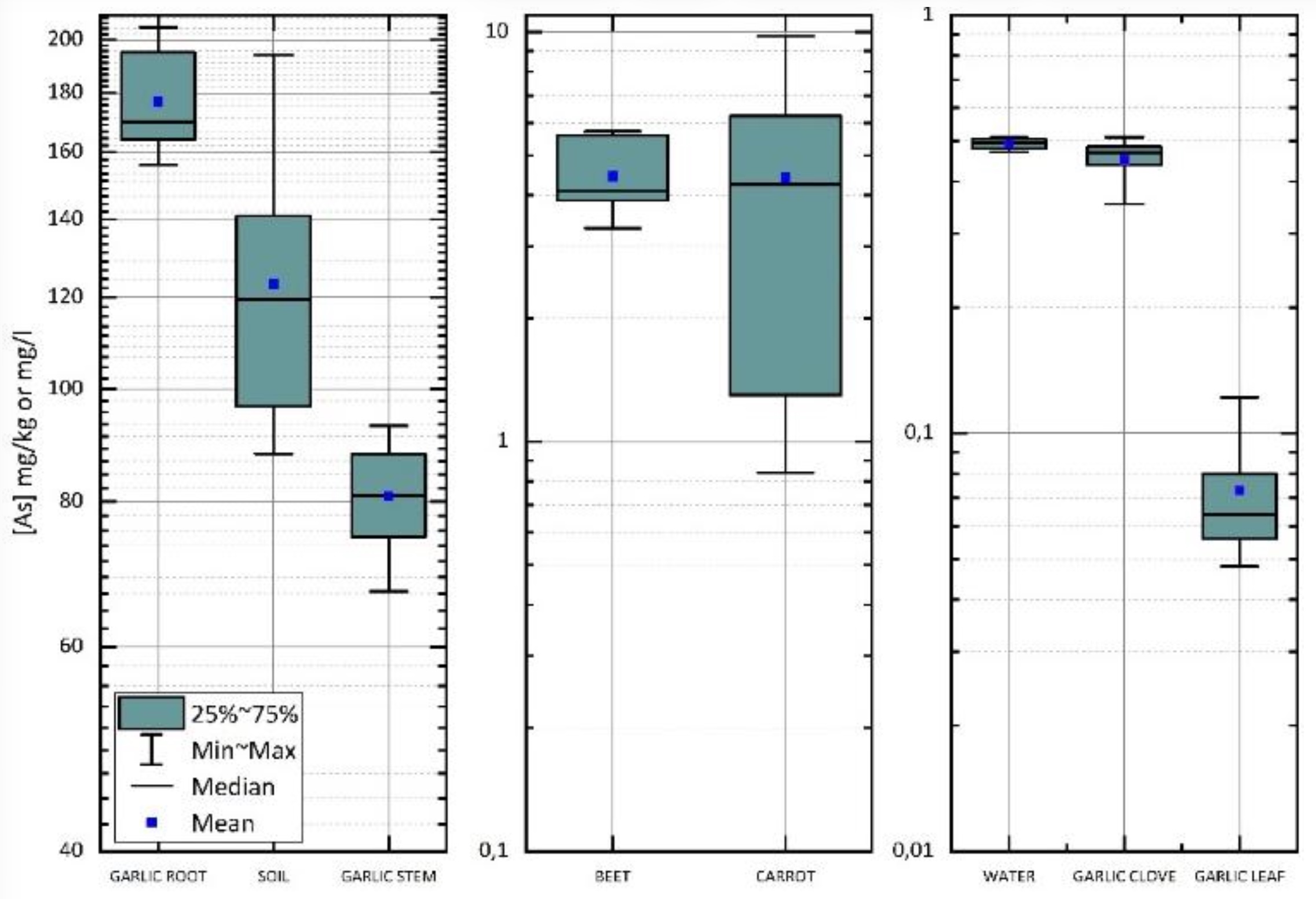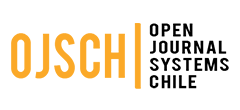MOBILITY OF ARSENIC IN ALLIUM SATIVUM, BETA VULGARIS AND DAUCUS CAROTA CROPS AT THE QUEBRADA DE CAMIÑA, NORTHERN CHILE
- arsenic availability bioaccumulation factor translocation vegetables
Copyright (c) 2024 SChQ

This work is licensed under a Creative Commons Attribution-NonCommercial-ShareAlike 4.0 International License.
Abstract
The ravine Quebrada de Camiña, in northern Chile, is valued for regional agriculture, however, it retains high levels of As. From four locations (Chapiquilta, Camiña, Moquella, and Francia), environmental factors that affect the mobility of As were evaluated through the characterization of water quality and soil physicochemistry used for local crops of white garlic, beetroots and carrots; Contamination Factors, Geoaccumulation Index (CF-IGEO), and operational speciation by BCR protocol in soils; Bioaccumulation Factors (BAF) and Translocation Factors (TF) for root-stem-bulb-leaves of Camiña white garlic plants, and BAF in beetroots and carrots. The results showed that water used in crops are slightly alkaline, mineralized with B and Na+-Ca2+/Cl--SO42-, that mobilize As (0.49 ± 0.02 mg/l) to the soils and are part of the fraction available and assimilable by the vegetables. The CF-IGEO of saline soils showed low easily oxidized organic carbon, neutral pH and high levels of B, with moderate to considerable degree of total As contamination (123 ± 34 mg/kg); in fact, after soil As extraction protocol, 19% of As is found in the more available fractions and 79% in the residual phase, while a positive correlation with total As was observed. White garlic plants bioaccumulate As in roots (177 ± 18 mg/kg) and stems (81.0 ± 8.1 mg/kg), while the edible bulb (0.451 ± 0.054 mg/kg) and the leaves (0.073 ± 0.025 mg/kg) do not present a consumption risk. As translocations from root to stem and from bulb to leaves are observed. As in freeze-dried samples of beetroot (4.45 ± 0.98 mg/kg) and carrot (3.26 ± 3.50 mg/kg) showed fluctuation, exceeding national and international food standards.

References
- B. Mandal, K Suzuki, Talanta. 58, 201-235, (2002)
- D. López, J. Bundschuh, P. Birkle, M. Armienta, L. Cumbal, O. Sracek, L. Cornejo, M. Ormachea, Sci. Total Environ. 429, 57-75, (2012)
- L. Cornejo, H. Lienqueo, P. Vilca, Desalin. Water Treat. 153, 36-45, (2019)
- A. Caporale, P. Andamo, S. Azam, M. Rao, M. Pigna, Chemosphere. 193, 464-471, (2018)
- J. Tapia, B. Schneider, M. Inostroza, F. Álvarez, J. Luque, F. Aguilera, S. Parra, M. Bravo, J. S. Am. Earth Sci. 105: 102905, (2021)
- G. Pincetti-Zuñiga, L. Richards, L. Daniele, A. Boyce, Sci. Total Environ. 806, 150206, (2022)
- A. Issanov, B. Adewusi, N. Saint-Jacques, T. Dummer, Toxicol. Appl. Pharmacol. 483, 116808, (2024)
- L. Romero, H. Alonso, P. Campano, R. Fanfani, R. Cidu, C. Dadea, T Keegan, M. Farago, J. Appl. Geochem. 18 (9), 1399-1416, (2003)
- I. Pizarro, M. Gómez-Gómez, J. León, D. Román, M. Palacios, Sci. Total Environ. 565, 557-563, (2016)
- A. Vandeurem, B. Pereira, A. Kaba, H. Titeux, P. Delmelle, Sci. Total Environ. 902, 166073, (2023)
- C. Bergqvist, R. Herbert, I. Persson, M. Gregor, Environ. Pollut. 184, 540-546, (2014)
- V. Antoniadisa, E. Levizou, S. M. Shaheen, Y. Sik Ok, A. Sebastian, C. Baum, M. Prasad, W. Wenzel, J. Rinklebe, Earth-Sci. Rev. 171, 621-645, (2017)
- I. Khan, S. Afzal Awan, M. Rizwan, S. Ali, X. Zhang, L. Huang, Environ. Pollut. 286, 117389, (2021)
- S. Singh, J. Karwadiya, S. Srivastava, P. Kumar Patra, V.P. Venugopalan, Ecol. Eng. 175, 106476, (2022)
- Z. Chi, K. Pi, Y. Wu, X. Xie, Y. Wang, Ecotoxicol. Environ. Saf. 283, 11625, (2024)
- T. Zhang, B. Zheng, M. Wang, J. He, S. Xia, Gondwana Res. 130, 131-139, (2024)
- Ph. Quevauviller. Trends Anal. Chem. 17(10), 632-642, (1998)
- T. Karak, O. Albollino, P. Bhattacharyya, K. Das, R. Paul, Chemosphere 85, 948-960, (2011)
- K. M. Upadhyay, A. Shukla, P. Yadav, S. Srivastava, Food Chem. 276, 608-618, (2019)
- M. Varol, K. Gündüz, M. Ras¸ I. Sünbül, H Aytop, Environ. Res. 206, 112252, (2022)
- R. Calderón, J. García-Hernández, P. Palma, J. B. Leyva-Morales, M. Godoy, M. Zambrano-Soria, P. J. Bastidas-Bastidas, G. Valenzuela, J. Food Compos. Anal. 123, 105527, (2023)
- V. Herrera, C. Carrasco, P. Sandoval, C. Cortés, Rev. Soc. Quim. Perú. 83(1), 52-64, (2017)
- E. Lictevout, C. Maass, D. Córdoba, V. Herrera, R. Payano, “Recursos Hídricos, Región de Tarapacá: Diagnóstico y Sistematización de la Información” Centro de Investigación y Desarrollo de Recursos Hídricos- CIDERH - Universidad Arturo Prat, Iquique, 223p. 2013
- APHA-AWWA-WPCF. “Métodos normalizados para el análisis de aguas potables y residuales” Ediciones Díaz de Santos, S.A.; Madrid, España. 1830p. 1992
- E. Custodio, M.R. Llamas, “Hidrología Subterránea”. Ediciones Omega SA, Barcelona, 2350p. 1983
- A. Sadzawka, M.A. Carrasco, R. Grez, M.de la L. Mora, H. Flores, A. Newman. Serie Actas. Instituto de Investigaciones Agropecuarias, CRI La Platina, Santiago, Chile. 2006
- N. Morales-Simfors, J. Bundschuh, I. Heralh, C Inguaggiato, A. Caselli, J. Tapia, F. Apaza, M. Armienta, M. Ormachea, E. Joseph, D. López. Sci. Total Environ. 716, 1-32, (2020)
- L. Figueroa, A. Newman, Idesia. 41, 133-137, (2023)
- FAO, “Water Quality for Agriculture Irrigation and Drainage Paper 29 Rev 1”. Ayers R.S.; Westcot D.W. 1985
- Norma Chilena NCh 1333. Requisitos de calidad del agua para diferentes usos. Diario Oficial de la República de Chile, Santiago, Chile, 22 de mayo de 1987. Norma Chilena NCh 409/1.“Agua potable-1-Requisitos”. Diario Oficial de la República de Chile, Santiago, Chile, 27 de junio de 2006.
- Mazzilli S, Ernst O, Sastre A, Terra G. Agrociencia Uruguay 19, no.1 (2015).
- S. Cortes, E. Reynaga-Delgado, A.M. Sancha, C. Ferreccio, Sci. Total Environ. 410-411, 96-101, (2011)
- S. Chen, M. Wang, Journal of Integrative Agriculture, 17 (4), 765-774, (2018)
- Norma Peruana Decreto Supremo N° 011-2017-MINAM de Estándares de Calidad Ambiental (ECA). Perú, 2017
- W. Wang, X. Yang, Q. Mo, Y. Li, D. Meng, H. Li. Ecotoxicol. Environ. Saf. 259, 115004, (2023)
- Ministerio de Salud, División Jurídica. Reglamento Sanitario de los Alimentos; Decreto Supremo DS977, Santiago, Chile, 1996

